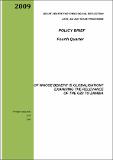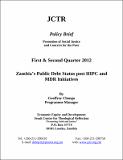Browsing Public Finance Management by Issue Date
Now showing items 1-20 of 50
-
An Assessment of The Problems / Obstacles Faced By Informal Cross Border Traders in Zambia: The Case For Chipata And Livingstone Towns
(2002)This study assesses the problems / obstacles faced by informal cross border traders in Zambia, using Chipata and Livingstone towns as case studies. The; study ’was done with the understanding that Zambia is part of the ... -
Report on the Jubilee Zambia Debt Campaign Opinion poll
(2002)The World Bank and the IMF launched the Heavily Indebted Poor Countries (HIPC) initiative of debt reduction in 1997 in an attempt to address the debt problems of severely indebted low-income countries. As of January 2002, ... -
Final Report of the Evaluation of the Debt Project (October 1998-December 2001)
(2003-03-04)The CCJP/JCTR debt project was established in 1998 with the purpose of securing an ethical outcome to Zambia’s external debt problem, viewed as a burden on the people by the project holders. The main purpose of the evaluation ... -
Zambia’s Experience With HIPC
(2004)The HIPC Initiative was first launched in 1996 by the International Monetary Fund (IMF) and the World Bank, with the aim of ensuring that no poor country faces a debt burden it cannot manage. The Initiative entails coordinated ... -
Human-Needs Based Debt Sustainability Analysis: A Challenge For Zambia
(2005-06)In this report. Jubilee Zambia presents a proposal of a set of guides on the development of a human- needs based Debt Sustainability Analysis Framework (DSA.). This proposal is formulated with a view to stimulate dialogue ... -
Zambia After The HIPC ‘Surgery’ And The Completion Point
(2006)“We reached the heavily indebted poor countries (HIPC) Completion Point in April 2005 and so what?” asked a workshop participant in one of the Jubilee-Zambia Provincial Workshops. Indeed many other Zambians are asking ... -
Economic Partnership Agreements: A Challenge for Trade Justice
(2007)In the last three years, the Debt and Trade Project (now Debt Aid and Trade Programme, DAT) of the Jesuit Centre for Theological Reflection (JCTR) invested in understanding the trade challenges faced by Zambia and other ... -
An Evaluation of The Strengths And Weaknesses of Public Debt Management in Zambia And Management Legal Review
(2007-11)Zambia’s external debt has had a number of effects on the Zambian economy. The HIPC debt agreement, coined in 1996 to help countries like Zambia faced with a huge debt problem and a high fiscal deficit resulted in Zambia ... -
Domestic Resource Mobilisation For Sustainable Development
(2008)To ensure that there is equity in bearing the tax burden. The tax burden in Zambia is borne largely by about 500, 000 workers in the formal sector. There is need to ensure that equity prevails where all contribute to the ... -
Debt Resource Monitoring Manual
(2008)The achievements made so far in the campaign for debt cancellation need to be complemented by prudent management and utilisation of debt resources in the post HIPC era. In order to facilitate transparency and accountability ... -
Of Whose Benefit is Globalisation? Examining the Relevance of the G20 to Zambia
(2009)The G20, unlike other forms of international cooperations like the United Nations, is an informal forum that promotes discussion between industrialised and emerging-market countries on key issues related to global economic ... -
APRM in Zambia
(2009-03)There are questions that many Zambians have! But not many of us have good answers! Not only do Zambians ask questions about governance, but so do the citizens of so many other African countries. And that is why there is - ... -
Debt Resource Monitoring Report (DRM)
(2010-11)The poor water supply and sanitation situation in the Central Province resulted the Zambian government to acquire a loan and grant amounting to US$33 million from the African Development Bank (AfDB) to embark on a US$36.9 ... -
Debt Resource Monitoring Report
(2010-11)Good road infrastructure is cardinal in the promotion of viable economic activities. This is even more so for the agriculture sector which relies on the road network for transportation of agricultural inputs such as seed ... -
Resource Mobilization For Sustainable Development: Best Practices
(2011)Every government needs to mobilize financial resources to finance its development programme. The need to mobilize sufficient financial resources is even more urgent for developing countries like Zambia, as they have more ... -
Does Aid Transparency Make for More Effective Aid? A Case Study of Lusaka Province
(2011)The movement for increasing aid transparency has gained significant momentum in recent years. The purpose of this study is to analyze the link between aid transparency and aid effectiveness. Several studies do not corroborate ... -
The Taxation System in Zambia
(2011-01)Zambia is facing tax performance challenges that need to be addressed urgently. The declining tax performance in the recent past has been caused by the proliferation of tax incentives in Zambia. The premise of this study ... -
Study to Identify Challenges and Potential Success Factors Regarding Public Finance Management in Zambia
(2011-12)This study was commissioned by the Jesuit Centre for Theological Reflection (JCTR) to explore ways of promoting effective and efficient public resource management and service delivery through transparency, social accountability ... -
Zambia’s Public Debt Status Post HIPC And MDR Initiatives
(2012)The Public Debt reforms that the Zambian Government embarked on in 2004 aimed at strengthening debt management capacities of various Government institutions engaged in debt management should be accelerated. Currently, the ... -
Wastage Of Public Resources Should Never Be Allowed To Continue
(2012-02-01)Fighting poverty and ensuring that every Zambian has access to basic needs such as food, health care, safe shelter, safe and clean water, basic sanitation, education and livelihood can never be achieved without prudence, ...




















